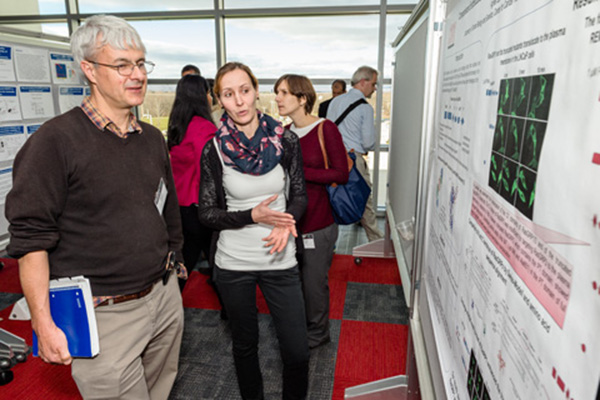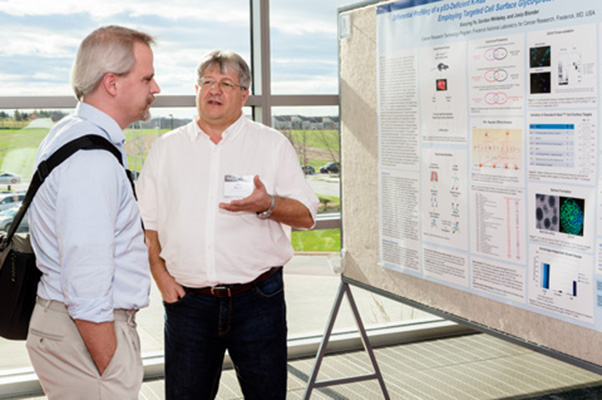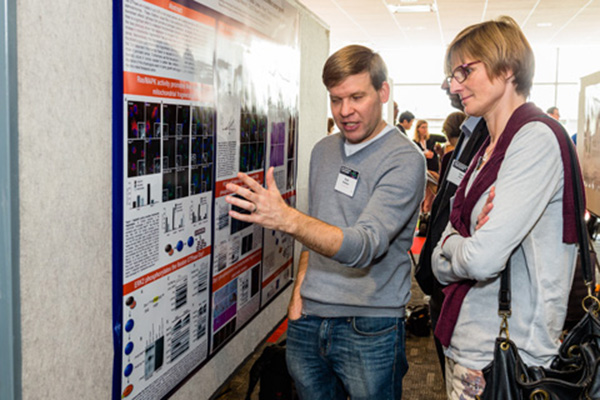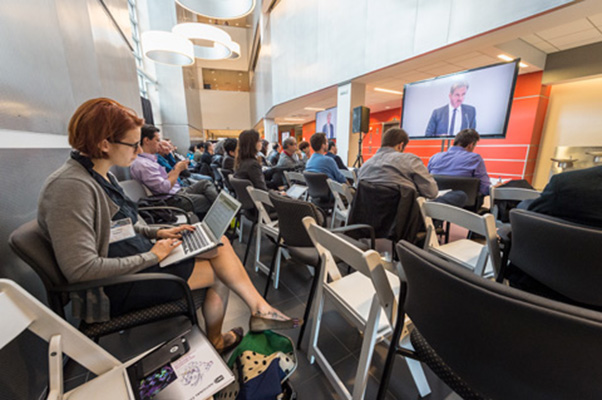They call themselves “rasologists”: scientists who study the RAS family of genes and the cancers that can arise due to mutations within them. This field of research is at the heart of some sobering numbers. Almost a third of all human cancers, including 95 percent of pancreatic cancers, are driven by mutated RAS genes. The American Cancer Society estimates there were 48,960 new cases of pancreatic cancer in the United States in 2015 and 40,560 deaths from the disease. A high proportion of lung and colorectal cancers are also driven by mutations in RAS.
On Dec. 15 and 16, hundreds of rasologists and interested colleagues came together at the Frederick National Laboratory for Cancer Research (FNLCR) Advanced Technology Research Facility to share results of their studies and discuss the state of RAS science.
RAS has long been recognized as a culprit for cancer. KRAS, HRAS, and NRAS—members of the RAS gene family—encode certain proteins (complex molecules that do most of the work in cells). These proteins play a pivotal role in cell signaling within the cytoplasm (the jelly-like substance enclosed within the cell membrane). When RAS genes become mutated, cells can grow uncontrollably and evade normal death signals. In other words, those cells become cancerous. RAS mutations and some of the pathways RAS genes control are well known. But piecing together all of the potential mechanisms of action of these pathways has been dizzyingly complex; to date, scientists have been stymied in their attempts to develop drug therapies against mutant RAS proteins.
In 2013, NCI held a series of workshops, at which researchers discussed recent evidence suggesting new ways of potentially targeting RAS or the unique features of RAS-driven cancers. Those meetings ultimately led to the NCI RAS Initiative, which is now centered at FNLCR, under the leadership of RAS expert Frank McCormick, Ph.D. The initiative brings together collaborators from academia, government labs, biotech companies, and drug companies, to bring new technologies and new ideas to the study of RAS, with the goal of developing new therapies. It seems clear, at this point, that the initiative is drawing attention.
Organizers of the symposium hoped to draw 200 people. More than 550 applied to attend, reported Acting NCI Director Doug Lowy, M.D., at the opening session. “We really have been overwhelmed by this tsunami of interest in RAS,” he said.
Lowy spoke about the importance of face-to-face meetings of RAS researchers. “We come away, really, with renewed understanding and thinking about new things that we might be able to do and, hopefully, as a result of the interactions that occur here, with some new collaborations…to execute some new ideas.”
During the symposium, more than three dozen speakers and approximately 125 poster presentations covered the spectrum of RAS research, including structure, biophysics, localization, signaling, alleles (alternative forms of a gene), tumor metabolism, modeling tools, and therapeutic approaches. Speakers also discussed how much work remains to be done, particularly in the search for effective therapies free of significant toxicities.
The success of the meeting and the overwhelming interest among scientists are proof of the power of NCI to convene researchers and spark new excitement in fields like RAS, said FNLCR’s Director, David Heimbrook, Ph.D. A world-class list of speakers drew a huge crowd of RAS researchers to FNLCR, and new collaborations and scientific advances will occur as a result.
Richard Folkers is the communications manager of NCI at Frederick.






